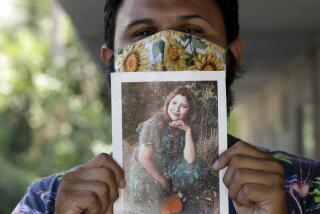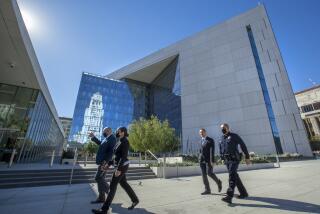L.A. to pay $13 million to settle May Day melee suits
The City Council on Wednesday agreed to pay nearly $13 million to people injured or mistreated in a May Day melee in MacArthur Park, bringing to more than $30 million the money spent over the last two weeks to settle lawsuits alleging LAPD misconduct.
The action served as a reminder of the Los Angeles Police Department’s troubled past and its continuing path toward regaining the trust of some city residents and elected officials.
For the LAPD, Wednesday’s $12.85-million payout -- covering most of the claims by immigration demonstrators and bystanders injured May 1, 2007, in MacArthur Park -- has a few strings attached.
Under the settlement, the department must submit to court oversight of its crowd control procedures -- another layer of federal involvement that comes as LAPD leaders are impatient to be free of a long-standing and more onerous monitoring program imposed after the Rampart Division corruption scandal.
The May Day settlement, approved unanimously by the council, comes a week after members agreed to pay $20.5 million to settle civil rights lawsuits filed by four current and former LAPD officers, three of whom were awarded $15 million by a federal jury after claiming to have been falsely arrested and maliciously prosecuted during the Rampart probe. That sum was on top of more than $75 million the city has paid to civilians affected by the 1999 scandal.
“Over $32 million in these last two weeks on Police Department litigation cases -- that’s a tremendous amount of money,” Councilman Dennis Zine said after the 11-0 public vote. “My concern is that the Police Department needs to be held accountable and responsible. . . . There are still other cases pending. This isn’t the end.”
He added, “While crime’s down, we respect that, the conduct of the officers is important, and the management of the department is ultimately responsible for that.”
Council President Eric Garcetti noted that the cost of the May Day agreement was enough to hire almost 130 police officers. “It underscores why police reform is as important as police hiring,” Garcetti said. “A handful of officers can cost the city millions of dollars. We saw that in Rampart; we’re seeing that here -- more than a handful here.”
The settlement approved Wednesday will resolve a class action lawsuit and more than half a dozen individual lawsuits in federal court. It accounts for a large portion of the more than 300 May Day claims against the city.
The allegations of police mistreatment and excessive force resulted from clashes in MacArthur Park as an immigration march wound down. Officers from the LAPD’s elite Metro Division used batons and fired rubber bullets to disperse what was a predominantly peaceful gathering. Officials said the confrontations were prompted by a group of agitators who threw bottles and other objects at police. Dozens of people, including a number of journalists and police officers, were injured.
“Our clients are really very happy with this,” said Carol Sobel, a lawyer for some of the plaintiffs, after the agreement was announced. “What it stands for is recognition that the police were wrong.”
Councilman Ed Reyes, who represents the MacArthur Park area west of downtown, said the settlement was part of a community healing process.
“This was very, very critical,” he said. “Now we can say we acknowledge our mistakes; we are making every effort to address the weaknesses in our process, in our implementation as a Police Department, and more importantly recognizing that the community does matter. We’re giving them the value they deserve in terms of reaching a settlement and helping those who are hurt.”
Two other May Day cases are pending in federal court, and there are 15 in state court, said a spokesman for the city attorney. Only one related case, involving a broken camera, was settled before this week.
Nick Velasquez, a spokesman for City Atty. Rocky Delgadillo, declined to estimate the expected cost of the remaining litigation. But he said the settlement covered more than 90% of the cases filed in federal court by demonstrators. The agreement covers costs and legal fees, and preempts any of the 5,000 people who had gathered in the park from filing a class-action case in the future, Velasquez said.
With graphic images of the violent chaos recorded by photographers and television crews in the park, the melee gained immediate worldwide attention. It dealt a serious public relations blow to a Police Department that under Chief William J. Bratton has made a deliberate effort to shake a reputation for brutality that stemmed from the 1991 Rodney G. King beating, the Rampart scandal and other incidents.
In the immediate aftermath, Bratton removed two command-level officers from their posts and created the Critical Incident Management Bureau, which oversees the department’s handling of major events and protests. In September, after a long internal investigation that detailed the breakdown in command that led to the melee, Bratton announced plans to suspend 11 lower-ranking officers and called for the termination of four others for excessive use of force, failing to rein in other officers or lying to investigators during the inquiry.
Under the terms of the agreement approved Wednesday, the way the LAPD responds to large crowds is cemented in writing. It leaves the department considerable discretion, but nonetheless places limits on when police can break up a gathering and when they can use force on crowds.
Batons, for example, can be used to push -- but not strike -- protesters who refuse a police order to disperse. Less-lethal projectiles, such as rubber bullets and bean bags, can’t be used on a peaceful crowd that’s retreating, and police helicopters must not disrupt speeches and marches by flying too low.
For at least the next four years the judge who has overseen the May Day settlement negotiations will also watch the department’s handling of future protests to ensure that it abides by the agreement. A more sweeping oversight stemming from Rampart has also followed the department for the last several years.
Sobel acknowledged the LAPD has made improvements since 2007, but said the agreement was a needed safeguard. The department, she stressed, made similar promises when the city settled claims after the 2000 Democratic National Convention, where police clashed with protesters.
“The key question with the LAPD has always been, ‘How do you move from an agreement on paper to real institutional change? How do you change the culture?’ ” she said. “There have been really good signs, but every once and a while they slip back.”
Although several council members praised Bratton’s response to the melee and the LAPD’s retraining efforts, they added that the department’s internal report on the incident made it difficult for the city to defend the lawsuits in court.
“They brought officers up on charges; they admitted errors. So when you admit errors, then what are you going to do for a defense?” Zine said, adding that city lawyers advised council members that going to trial would be “extremely expensive.”
Garcetti said he was satisfied with the department’s reforms, which he said “brought back what should have been common sense training.”
“To say that we are 100% of the way there -- I don’t believe that we are,” he said, “but the way in which the department responded was a sea change from the past in taking immediate responsibility, not just along the rank-and-file level, but up the chain of command.”
--
More to Read
Sign up for Essential California
The most important California stories and recommendations in your inbox every morning.
You may occasionally receive promotional content from the Los Angeles Times.












